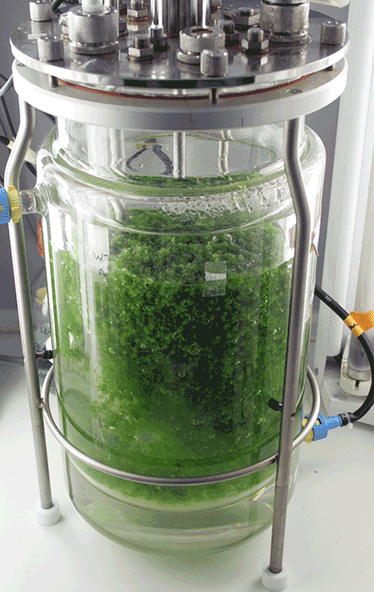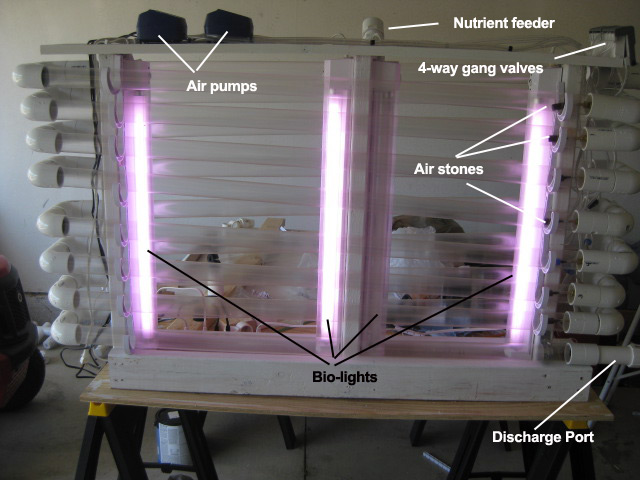
There's a lot of untruth swirling around cyberspace in regards to algae photobioreactor. On one hand you have engineers and manufacturers complicating the fabricating process. I guess they don't want people to know anyone can do this. On the other hand, in the DIY space you have people spouting using materials that clearly aren't designed for the job you're asking them to perform.
So this is my attempt to set the record straight.
Algae Photobioreactor-Advantages and Disadvantages
Pros

- Prevent contamination: One of the biggest problems with opens ponds (in my view anyway) is they are susceptible to contamination from invading and/or native species. In a PBR all inputs are completely controlled by you, not chance or nature. This is a HUGE advantage.
- Allow you to grow algae in any climate: This is one of the main reasons for a PBR. It allows you to grow algae easily and cheaply in almost any climate. Open ponds are an unacceptable alternative in many colder climates.
- PBR’s offer better control over existing conditions: Since you’re controlling all the inputs, you can also (better) control the existing conditions of your algal experiments. Meaning climate, light, temperature, Ph balance, nutrients, etc. Many times this isn’t possible in an open pond situation. For example it is hard to control the amount of sunlight in a given location. However with a PBR it is as simple as resetting a timer.
- Prevent water evaporation: Water evaporation in an open pond can be difficult situation to control. Where water is scarce this makes open ponds an unacceptable choice.
- Lower carbon dioxide losses: If you have a unlimited source of waste carbon dioxide this isn’t a problem, however most home users aren’t in a situation of living next to a power plant…they have to buy it in canisters. In order to minimize costs, this becomes a consideration.
- Permit higher cell concentrations: Because you’re controlling the parameters of the PBR, you can also control the density of your cell colonies. While possible in an open pond, it is much easier in a PBR.
Cons

- Cost: Until now, a photobioreactor was considered the realm of corporations due to the high cost of fabrication. Indeed the high cost of acrylic tubes, especially as the price of oil increases, is enough to give one pause. The key to controlling the cost of PBR’s is in “Yankee ingenuity.”
- Sure, it’s always possible to complicate things and charge extra. No problem there. However to use existing inexpensive, local resources to create a photobioreactor the knowledge has been non-existent. Until now. That is one of the main reasons for producing this book.
- Size and scope: For the most part, PBR’s have been confined to laboratories with relatively few being fabricated for large scale production. That is now changing. The size and scope of your PBR is also dependent on your application. Many (most) uses don’t require a large scale PBR…health food supplements, for example. You can easily make all the Spirulina and/or chlorella your family would need with a small photobioreactor. Algae bio fuels for example, go to the opposite end of the spectrum. Here you need to produce a large amount of algae to be successful.
Technical Expertise: Here is what one forum board “expert” had to say About Building Photobioreactor…
“What you will need to read before starting with a design of a photobioreactor is:
- 1. Physics of fluids (viscosity, velocity, laminar and turbulent flow), light (wavelength, brightness), pressure.
- 2. Fluid flow mechanics for Newtonian and non-Newtonian fluids.
- 3. Thermodynamics (basics).
- 4. Heat transfer through different materials.
- 5. Mass transfer in different media (gas transfer from sparger to fluid, and from fluid to cell).
- 6. Light transfer (when interested in PBR).
- 7. Basic biology of the cell (plant cell, when interested in PBR for algae production).
- 8. Chemistry (basics).
- 9. Mathematics (differential equations).
- 10. Be extremely careful with experimental design, when decided to proof that some PBR works.
Summary: PBR design is extremely complex task, and I will advise anyone who is not an expert in the field not to take any chances by designing it by themselves. It simply will not work.”

Even my dog is confused. The only thing he left out was quantum physics and brain surgery.
Nothing could be further from the truth.
Here is the knowledge you REALLY need…
- The ability to use basic power tools without injuring yourself or others.
- The eBook found below
- A brain
- About $200 bucks.
And that’s about it. Since you are reading this page, it’s obvious you have a brain. You’re 50% of the way there already. :+) With those 4 things you’ll be able to build, operate, and grow algae in a photobioreactor.
My point here is you DON’T HAVE TO OVER-COMPLICATE THINGS.
Sure, more knowledge is better than less. (After all, that’s why you are reading this page, right?) But the expert opinion above is like saying you need to be an astronaut to fly a paper airplane
You also be interested in...

The Algae Bioreactors
In algae bioreactors, algae growth conditions can be regulated much easily and precisely by engineers. Read More

Algae Photobioreactors
Find out the advantages and disadvantages of using an algae photobioreactor...Read More

Building Algae Bioreactors at Home
Forget what you've read on forum boards. building an algae photobioreactor is easier than you think... Read More
The Algae Revolution Has Begun
It will Be Our Bible...
Dear sir:
Great news! You are finishing to write one book expected for many years. During several months, I have been an constant follower of your ideas, papers and designs and there is no doubt of your worldwide mastery about biofuels. I am a Colombian researcher dedicated to participate in the Colombian project for production of biodiesel from native microalgae…. It will be as our Bible on those topics really urgent and necessary for the future wellfare of the humanity.
Thanks in advance
UNIVERSIDAD PEDAGOGICA Y TECNOLOGICA DE COLOMBIA



